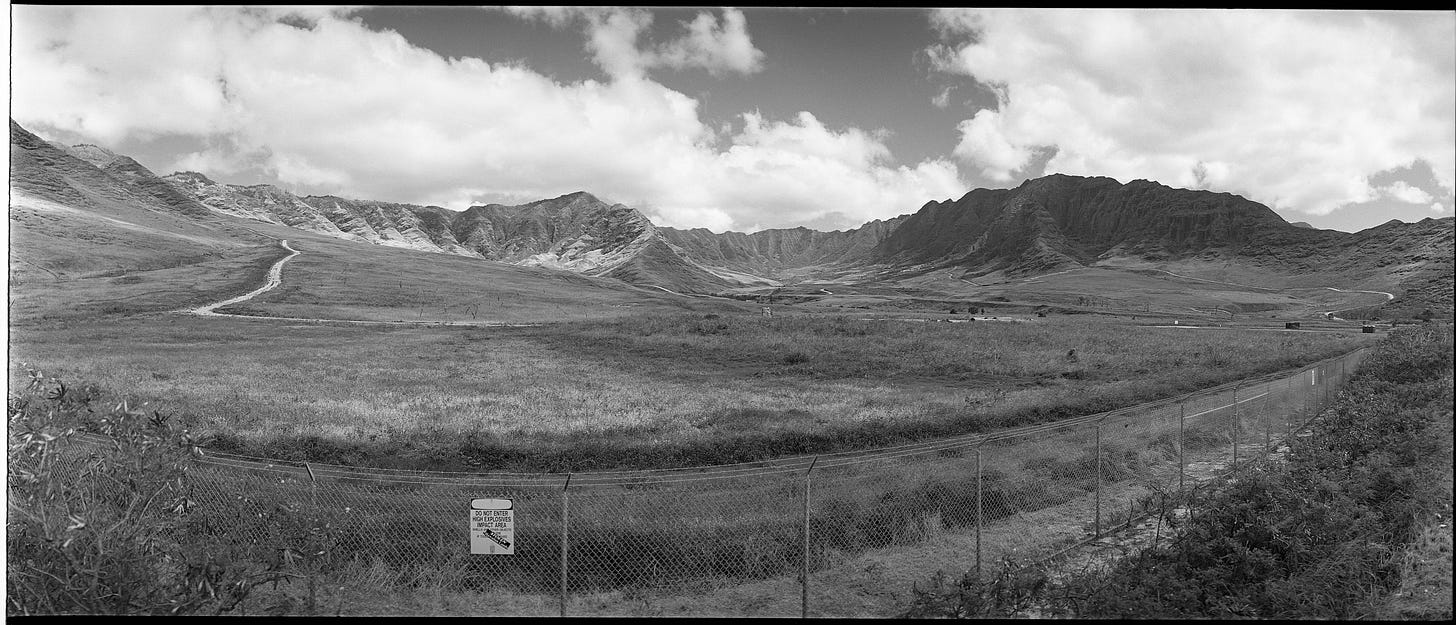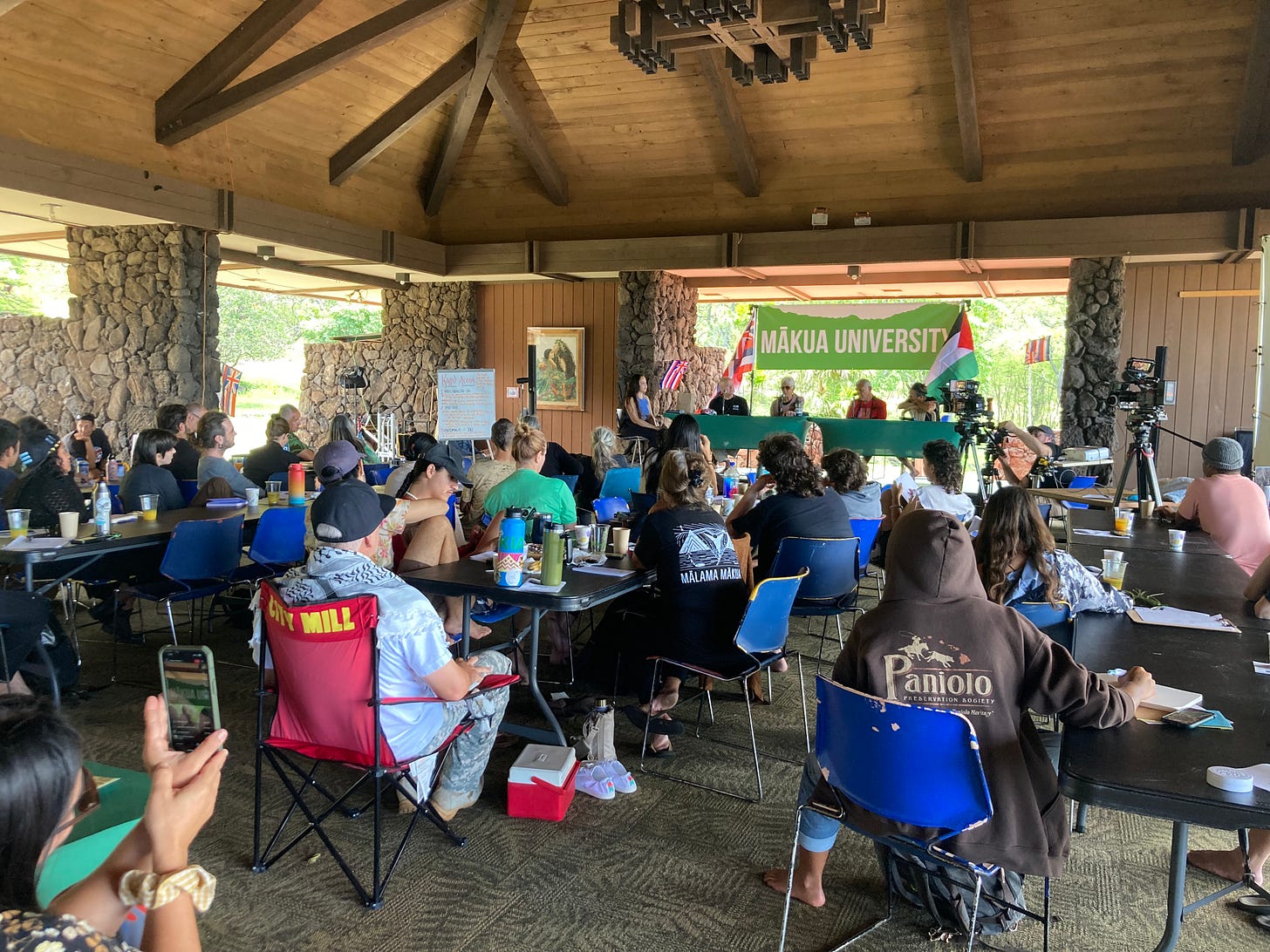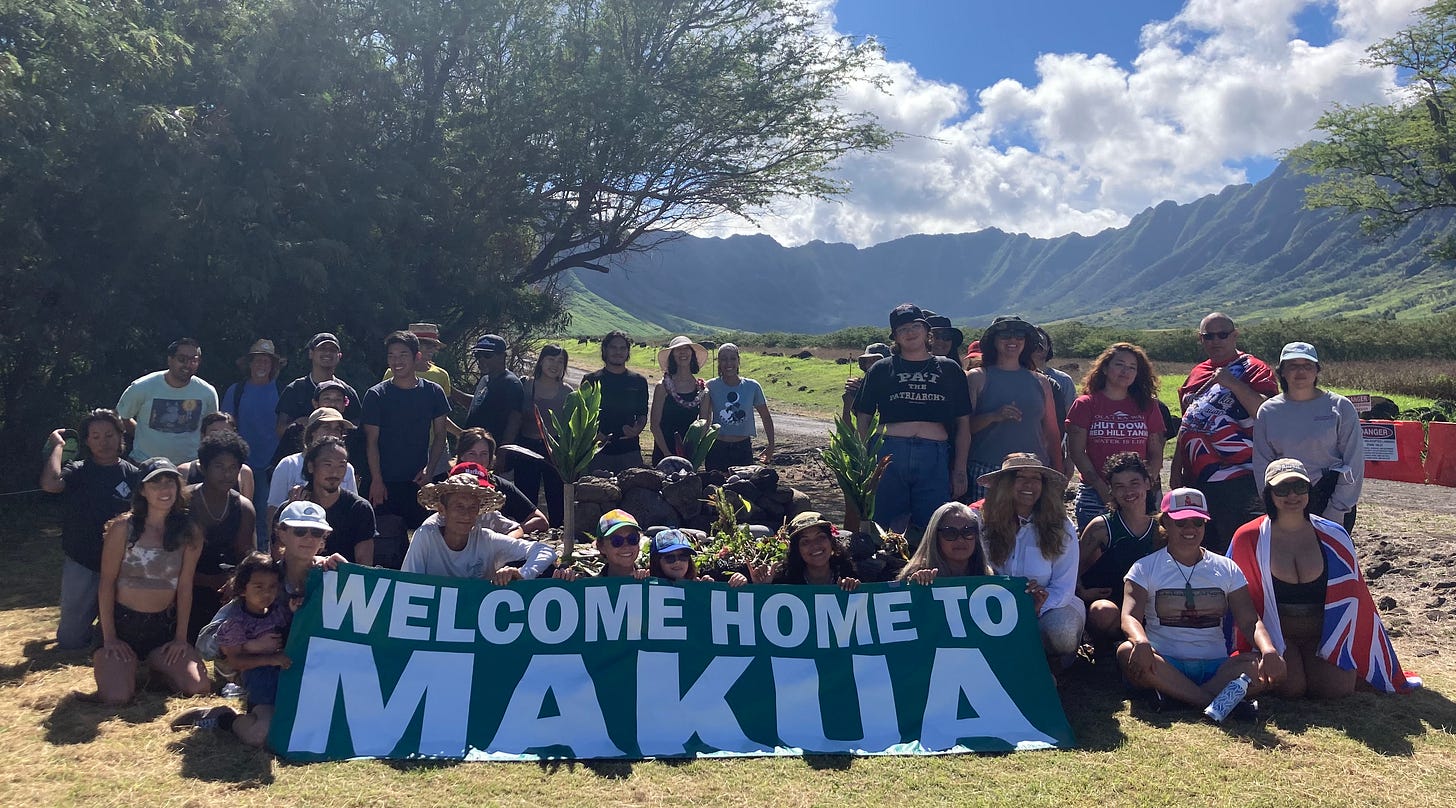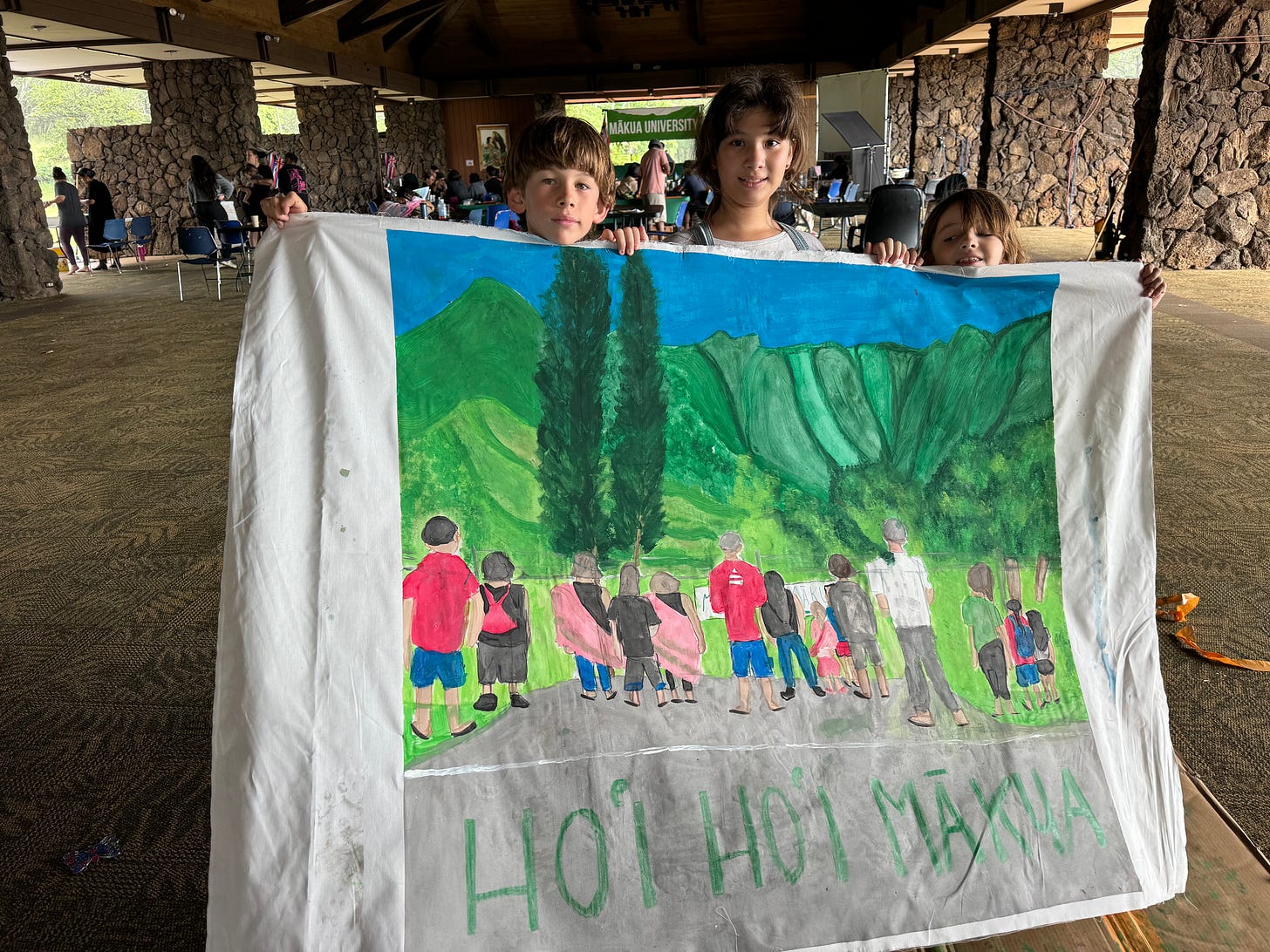When I sat down earlier this summer to talk with Laurel Mei-Singh, an assistant professor in the Department of Geography and the Environment and Asian American Studies here at UT Austin, she had just returned from five weeks in Hawai‘i. It wasn’t all vacation, though — much of her time while there was spent working on her project, “Mobilizing Community Knowledge to Protect the Sacred: Confronting the Militarization of Hawai‘i and Devastation of Indigenous Lands.” The project is supported by a grant from the Luce Foundation — the first large research grant for the university’s Center for Asian American Studies — first announced last fall.
Now that some time has passed, I was interested to learn more about how Mei-Singh’s work was progressing. Over iced coffee in central Austin, we talked about militarism, militourism, the way some places seem to have a spirit and agency all their own, and the importance of art for imagining new kinds of futures. Read on for a lightly edited and condensed version of our conversation, and for more about Mei-Singh’s research you can visit her faculty page here.
I'm interested in your work on this Luce grant in Hawai‘i, but also on your scholarship generally, and they seem really connected. But to start: What were you doing for the last five weeks you were in Hawai‘i? What were you working on?
The Luce grant is to support existing initiatives in Hawai‘i to reach consensus for the future of military lands. The one in particular that we're focusing on is called Makua Military Reservation. It's a roughly 4,000-acre base that the U.S. military seized a couple of days after the bombing of Pearl Harbor, right after the U.S. government declared martial law over Hawai‘i, and they promised to return the land after the war but never did. Then, during the Vietnam War in 1964, LBJ signed an executive order for a 65-year lease for $1 total for a portion of that military land. That lease ends in 2029, so it's a really exciting opportunity to envision the future of the land. The military is making moves to assess its value so that they can make arrangements to swap other lands to continue holding onto it, but at the same time there have been decades and decades of grassroots mobilizations and organizing to protect the land.
The main thing that the military has done since World War II is use the land for live fire training. Hundreds of thousands of tons of unexploded ordinances and bombs have been dropped into the valley. But just as of December, the U.S. military has announced that it will no longer use the land for live fire training to ensure compliance with the Endangered Species Act, because this is a fairly isolated valley and there are a few species that only exist there. There's now a good chance that the military will return the land fully, but we need to be really mobilized as a community.
For this project, I'm working in partnership with this community that I've been working with for the last 10 years, since I was working on my dissertation. One of their biggest identified needs is for widely accessible materials for the public to educate them and inform them about this issue and help sway public opinion towards the return of this land. The other need is for an articulated vision for the future of that land. The Luce Foundation grant comes in to support both of those needs by creating a documentary film and a curriculum for high school and college-age students to educate them about the issue and to organize public dialogues. While I was there we organized Mākua University, a one and a half day retreat, to bring people together, educate them about issues, start talking about visions for the future for this place, and then work on plotting our next steps. We were also shooting for the film at this event as well as around the community, like at the local grocery store. One of the leaders of the group we work with, Mālama Mākua, he knows everyone. So we’ve been getting impromptu interviews, “man or woman on the street” style. It was really amazing and beautiful, because this valley is part of this community and people do feel a connection to it. Homeless people have lived there, particularly in the ‘70s, ‘80s, and ‘90s before homelessness really got policed, and they lived on the beach across the street from the military land. One of the workers at the grocery store actually grew up on the beach. Getting those kinds of interviews from the activists we've been working with but also just from regular, everyday people, it's really beautiful to see the connection that they have.
That's going to make for a powerful film. Who are you working with on the documentary part of this project? How do you see it fitting into the rest of your work around Mākua?
The documentary is working in tandem with my book project, and the book project is providing a broader overview of this area. In it I am looking at the broader picture of militarism in Hawai‘i and focusing on a community called the Wai‘anae Coast. It’s the west side of the island, west of the Wai‘anae mountain range, which shields the Wai‘anae Coast from the rest of the island. There's only one way in and one way out, so it's much more isolated, and it's a really small-town, rural community. About 66% of the people are Native Hawaiian and Pacific Islander, and about a third of the land is military bases. It's a poor, working-class community, and there's actually been a major spike of homelessness in Hawai‘i generally and in Honolulu in particular. Most of the homeless people in Honolulu are pushed out of the city and the more commercial centers into this rural community. But there's also beautiful community formation there, like self-governing villages of homeless people.
So, my book provides that larger picture of militarism but also how poverty and colonialism and racism work together in conjunction with militarism, and then the documentary hones in on one particular military base on the Wai‘anae Coast, among about three or four military bases in the area, depending on how you look at the geography. The purpose of it is to make my scholarship more broadly accessible. I envision that the readers of my book will be scholars and students, but I think documentaries can reach entirely different audiences, including high school students and people who may be less inclined to pick up a book. And I’m partnering with a Hawai‘i-based activist filmmaker. We actually went to the same high school — I'm from Honolulu — and this community is about an hour away from where we both grew up. He shows up at as many political events as he possibly can and just films, so he has massive amounts of footage of social movements in Hawai‘i that he also participates in. Now we’re working on this 30-minute short, so it's not a feature length yet until we get the funding for that.
Speaking about the funding, where did the idea for this grant proposal come from? How did you become involved with the Luce Foundation?
This grant is a partnership between the Luce Foundation and the Center for Asian American Studies at UT Austin. The Luce Foundation has a vibrant Asia program and it is particularly interested in funding work that looks at diplomacy between the U.S. and Asia. They approached the Center for Asian American Studies here at UT, and then the director of the center, Eric Tang, who is a co-PI on this grant, approached the Asian American studies faculty about this opportunity. And the idea for this project had just been marinating in my mind, the focus on the documentary film in particular because that's something that the Hawai‘i-based collaborators I have had been mentioning as a need in terms of their work. So, I pitched the idea to Eric, and then Eric and Laura Soto, who's in foundation relations at UT, initiated a dialogue with the Luce Foundation.
The way that we conceive of this project as fitting into the Asia program is considering Hawai‘i, or the Pacific Ocean and Pacific Islands, as a kind of borderland between the U.S. and Asia. It’s a place that mediates relationships between U.S. and Asia, and particularly with the kind of escalating rivalry between U. S. and China, that's often invoked in the rationalization and justification for the militarization of Hawai‘i and for securitizing Hawai‘i in order to make the United States more secure. And as we work on this project we're trying to conceive of other ways to ensure safety and security beyond militarism. So, thinking about food sovereignty as an essential element of security, or thinking about the cleanup of toxins, including military toxins, as essential to safety and security. And I think beyond safety and security, we’re thinking about how we can relate to each other in the world beyond inter-imperialist rivalry, like relating to each other in terms of diplomacy and mutually beneficial collaboration. This project thinks about that on a very localized scale, but that can inform things on a much broader scale.
It's interesting to think about Hawai‘i as a borderland — as a place that may share some similarities to places like Texas and the Southwest, though they’re very different on a surface level. In general Hawai‘i seems like a place that people in the mainland U.S. think about in a very shallow way. We all know about Pearl Harbor, but we mostly think about Hawai‘i as a place we visit for honeymoons and vacations. I, for one, didn’t realize until I started prepping for this interview just how many military bases there are in Hawai‘i.
One of the terms that one of my colleagues writes about is “militourism”: how the military and tourism work hand in glove with each other. The tourism is the more flexible, inviting, softer form of colonialism, and then the military is the more iron-fisted, destructive side of it. Tourism is also destructive, but it's not visibly destructive in the same way.
You said you grew up in Honolulu. What drew you to your research interest in the Wai‘anae Coast and the military presence in Hawai‘i?
My personal story is that the summer after I graduated from college, my dad and I went on a biking trip on the Wai‘anae Coast and then we decided to go for a swim at Mākua Beach. It's a protected bay, so it's really beautiful and magical. And he started talking to this woman named Leandra Wai, who had lived at Mākua Beach in the 90s until she was evicted in ’96. But she kept on returning to the beach pretty much every day and created this beautiful garden — she didn't like to call it a garden because she saw that as a Western term, but I don't know if there's another term in English to describe it — but it was like a rock garden with indigenous plants, and she would rake the sand every day. This was in 2004, and in 2003 there had been major fires in that area started by the military. I think the intent was to have controlled fires to burn up the unexploded ordinances, but they just went completely out of control. Leandra started talking to us about the fires, which had also uncovered heiau, which are Hawaiian temples, and all these cultural sites.
That memory became seared in my mind, and every time I went back home to Hawai‘i, I would drive out to that beach to look for her so I could talk to her more. Something about her just really captured me. She passed away right as I was finishing my dissertation in 2016, but her husband is still really involved with the group that she was working with, Mālāma Mākua.
Now they allow cultural accesses onto the base as part of a settlement agreement between Mālāma Mākua and the U.S. military, and oftentimes they ask, “What brought you here?” What brings me back to Mākua is that it literally called to me through Leandra, and it felt like it just like had this pull on me. And I'm not the only one who says that. “Mākua” means parents, so a lot of people talk about Mākua as this place of comfort, this place of safety, which is ironic because it's a place that the military has really destroyed. But when I do my work with the people from Mākua, something that people often say is, “We're not in charge, the military's not in charge, but Mākua's in charge.” It has this very lifelike, powerful force that pulls on people and holds onto them.
I love that way of thinking about a place or about land, because there are some parts of the world that do seem to have a kind of agency of their own.
In Hawaiian culture, the word that we use for family in modern Hawaiian is “ohana,” but historically the word that people have used for family is “‘āina.” And ‘āina means that which nourishes and sustains, and it usually refers to land. So the ‘āina has this force that has the capacity to provide and to connect, and Indigenous sovereignty and self-determination proponents describe a major source of sovereignty as the ‘āina.
The lease on this particular base in Mākua is up for renegotiation in 2029. Do the other installations in Hawai’i have similar agreements? Or is Mākua’s a unique circumstance?
There are four bases that are up for renegotiation in 2029, two additional ones on the island of Oahu and then one on Hawai‘i Island. The one on Hawai‘i Island is the biggest one — I believe it's over three times bigger than Mākua — and it's a very active base. The speculation of people I work with is that it’s very likely that the military will return Mākua as long as they're able to establish a long-term agreement for the use of Pōhakuloa, the base on Hawai‘i. So, it's also really important for us to be in communication with the people who live on that island.
If this land is returned, what is the hope for it? What is the plan looking ahead?
This is something we had extensive conversations about during our Mākua University retreat. There is one other model for it in Hawai‘i, which is the island of Kahoʻolawe off of Maui. It has a similar history — the military seized it during World War II and used it for bombing practice, but they bombed it so much that they broke the island’s water table. Now it's very difficult for people to inhabit it because of the water situation there. But Hawaiian sovereignty activists started fighting for it in the 1970s and they were able to reach a negotiation in George Bush Sr.'s administration to return the island to Hawai‘i. Now there’s a joint stewardship agreement between the state of Hawai‘i and a community group called the Protect Kaho‘olawe ‘Ohana, but the military has been really, really slow to clean up that land. The last statistic I heard was that only 15% of the unexploded ordinances and bombs have been cleaned up. So, I think people in Mākua are looking at it as a lesson learned. One of the big lessons is don't allow the state to have joint stewardship of the land. Instead, we think the best option is the formation of a community land trust. That will take a lot of study and research, but the idea is that it's very much community driven and not state driven. We want the land to be used for community-based agriculture, for an education center, and then there’s also the really important question of the lineal descendants, so the people who are descendants of the people who were evicted during World War II. We want to make sure that their voice is part of the process as well.
What are the next steps in your work with the Luce Foundation project?
As I wrote the grant, I envisioned phase two of the project would be an art exhibition by Indigenous artists. I think art and culture are really important components of this, in addition to policy. I was actually doing interviews on this recent trip for a separate project on attitudes towards U.S. militarism, and something that I realized people say as a mantra across the U.S. is, “we need the military because the military keeps us safe.” The reason arts are important is because they help us envision other kinds of worlds we can live in, where we don't need a military to keep us safe, or where the military would look vastly different from the way that it currently does, and we wouldn’t have to rely on violence and force to address conflict. We can find diplomatic means and ways of relating to each other that don't turn certain people into enemies and don’t rely on harming or killing them. I think art is really important to stoke our imagination about what other kinds of worlds are possible.
That was phase two of the grant as we envisioned it. Then at Mākua University the largest breakout group was an arts and culture and poetry group, and they, on their own, came up with the idea of a traveling art exhibition. So that's our next step, and the people who volunteered to do this are really excited about it They actually set a tentative date for the end of September and already put out a call for artists. We’ll hold that exhibition at the Wai‘anae Coast and call it something like “Life After Occupation.” So that's the most concrete next step.
We’re also working on finishing the documentary film, and hopefully we'll be able to screen it at UT Austin in the spring. And I have already started applying for funding for a more expansive exhibition and so that I can travel around Hawai‘i and into the U.S. continent and overseas to places like Guam, Puerto Rico, Okinawa, and other territories that are highly militarized to make those transnational connections.









